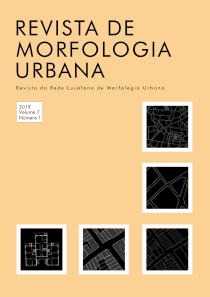Abstract
This article deals with relations between processes of spatial appropriation, urban vitality and morphology. Based on classical as well as contemporary authors, it finds support on empirical data recently produced. Urban analyses procedures tend to cut the ‘object city’ into pieces according to different disciplines – geography, history, sociology, anthropology, urbanism, etc.. Each one ‘reveals’ what it wants to see and obliterates what it considers irrelevant to its disciplinary purposes.
This paper addresses spatial appropriation of urban public space as agenerous processes – once triggered it acknowledges and aggregates multiple qualitative dimensions of the urban space, when thus allowed. Under certain conditions, they produces, temporary with consolidating perspectives, ‘urban nest’s – morphological configurations that support us, with more or less fruition, due to the local vitality it engenders. It focuses on the process of ‘urban nests making’ that proved important to locals’ quality of life. Illustrated by empirical studies this article finalizes pointing out new and older questions not always considered in urban analysis.
References
Anderson, C. (2008). The End of Theory: the data deluge makes the scientific method obsolete. [online] Condé Nast. Disponível em: http://www.wired.com/2008/06/ pb-theory [Acesso em 23 Julho 2019].
Arendt, H. (2007). A condição humana. 10th ed. Rio de Janeiro, Forense Universitária.
Aymonino, C. (1981). El Significado de las Ciudades. Madrid, Blume Ediciones.
Batty, M., Sulis, P., Manley, E., Zhong, C. e Batty, M. (2018) Using mobility data as proxy for measuring urban vitality. Journal of Spatial Information Science. 16, 137–162.
Brooks, D. (2013). The Philosophy of Data. The New York Times. Opinion. 4. Fev. 2013.
Careri, F. (2013). Walkscapes : O caminhar como prática estética. 1st ed. São Paulo, G. Gili.
Calthorpe, P. (1995). The next American metropolis: Ecology, Community, and the American Dream. 3rd ed. New York, Princeton Architectural Press.
Caniggia, G. e Maffei, G. (1995). Tipologia de la edificación – estructura del’espacio antrópico. Madrid, Celeste Ediciones.
Carvalho, T. (2017) Utopia no cotidiano-espaço público, desejo e fruição na formação da cidade. In: Netto et al. (eds.) Efeitos da Arquitetura: os impactos da urbanização contemporânea no Brasil. Brasília, FRBH.
Certeau, M. (1982). A escrita da História. Rio de Janeiro, Forum Universitário.
Claey, G. (2013). Utopia: a história de uma ideia. São Paulo, Edições SESC.
Conzen, M. (1960). Alnwick, Northumberland. A study in town-plan analysis. [With plates, plans and a bibliography.]. London, Institute of British Geographers Publication.
Cui, B. e Mao, M. (2018). Quantifying Vitality of Dashilanr: An Experiment Conducting Automated Human-Centered Observation. In: Z. Shen and M. Li, Big Data Support of Urban Planning and Management: The Experience in China. Fuzhou, Springer Nature, pp.389-413.
Cullen, G. (1971). Paisagem urbana. São Paulo, Martins Fontes.
Ferrara, L. (2000). Os significados urbanos. São Paulo, EdUSP.
Gehl, J e Svarre, B. (2018). A vida na cidade: como estudar. São Paulo, Perspectiva.
Han, B. C. (2018). Psicopolítica. Belo Horizonte, Âyné.
Harari, Y. N. (2016). Homo Deus. Rio de Janeiro, Companhia das Letras.
Hillier, B. e Hanson, J. (1984). The social logic of space. Cambridge, University Press.
Pont, M. (2017). Twenty-Fourth International Seminar on Urban Form. In: Conference report City and territory in the globalization age. Valencia, XXIV ISUF Valencia.
Krafta, R. e Faria, A. (2016). Morfologia Urbana, o Estado da Arte. In: Sessão temática: morfologia urbana. Porto Alegre, IV ENANPARQ.
Morfologia Urbana 2018-2 (2018). Relatório de avaliação final da disciplina do Mestrado em Arquitetura e Urbanismo da UFF. Niterói, PPGAU/EAU/UFF.
Nadai, M., Staiano, J., Larcher, R., Sebe, N., Quercia, D. and Lepri, B. (2016). International World Wide Web Conference Committee. The Death and Life of Great Italian Cities: a Mobile Phone Data Perspective. In: Proceedings of the 25th International Conference on World Wide Web, pp. 413–423. DOI:10.1145/2872427.2883084.
Oliveira, V. (2018). Diferentes abordagens em morfologia urbana. In: V. Oliveira (ed.), Diferentes abordagens em morfologia urbana. Contributos luso brasileiros. Urban Forms. Disponível em: http://vitoroliveira.fe.up.pt uf [Accessed 23 Jul. 2019].
Saboya, R., Netto, V. e Vargas, J. (2015). Fatores morfológicos da vitalidade urbana Uma investigação sobre o tipo arquitetônico e seus efeitos. Arquitextos, 180(02). Disponível em: http://www.vitruvius.com.br/revistas/ read/arquitextos/15.180/5554 [Acesso em 23 Julho 2019].
Sandercock, L. (1998). Towards Cosmopolis. Sussex, John Wiley.
Ünlü, T. (2018). Twenty-Fifth International Seminar on Urban Form, Krasnoyarsk, Russia, 5–9 July 2018. In: ХХV ISUF 2018. Krasnoyarsk, International Seminar on Urban Form, pp.164-165.
Tonkiss, F. (2013). Cities by design. Cambridge, Polity Press.
Yu, Y., Li, D. and Liu, X. (2018). How block density and typology affect urban vitality: an exploratory analysis in Shenzhen, China. Urban Geography, 39(4), 631-652. Disponível em: https://doi.org/10.1080/02723638.2017.1381536.
Whitehand, J. (2018). Twenty-Fifth International Seminar on Urban Form, Krasnoyarsk, Rússia, 5–9 July 2018. In: XXV ISUF 2018. Krasnoyarsky: International Seminar on Urban Form, pp.164-165.
Os direitos autorais permanecem com os autores, que autorizam a Revista de Morfologia Urbana a publicar o artigo sob uma licença Creative Commons Atribuição (CC-By).


